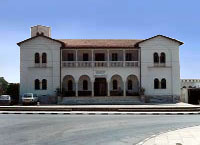|
|
 |
Güzelyurt Museum of Archeology
& Natural History
|
|
 The Güzelyurt Archeological and
Natural History Museum is housed in the old palace of the bishop of Güzelyurt (Morphou).
The ground floor of the museum is devoted to natural history and holds cabinets
of geological samples, stuffed fish, mammals, and birds native to Cyprus. Exotic
breeding migrants are represented by the elusive Eleanoras Falcon, the bright
plumage of the bee-eater and pink flamingos from the salt lakes. The Güzelyurt Archeological and
Natural History Museum is housed in the old palace of the bishop of Güzelyurt (Morphou).
The ground floor of the museum is devoted to natural history and holds cabinets
of geological samples, stuffed fish, mammals, and birds native to Cyprus. Exotic
breeding migrants are represented by the elusive Eleanoras Falcon, the bright
plumage of the bee-eater and pink flamingos from the salt lakes.
|
|
|
|
|
|
There is also a pair of mutant
lambs. A more symbolic age would have read the fate of Cyprus from these twins
with two heads on one body and two bodies on one head. Upstairs there is a small
archeological collection with the island's best display of Late Bronze Age white
slipware amd the recently discovered Ephesian Artemis.
|
|
|
|
|
|
|
|
|
Rooms II and III house pieces from Toumba Tou Skourou excavation, mostly base
ring-ware and very fine examples of the white slip -milk bowl- ware, with its
distinctive tatoo-like designs dated 1,600-1,500 B.C. Room V is filled with
artefacts from the Classical to Byzantine period, including two fine black on
red Attic Lekythos vases. Hellenistic tableware, Roman glass and yellow-glazed,
and medieval sgraffito pottery. The room is dominated by the statuette of
Artemis of Ephesus, carved in the 2nd century A.D. The weatheres white body of the goddess, whose black face bears remnants of a tidy
coiffure, was discovered in the Bay of Salamis in 1980.
|
|
|
|
|
|
Thirty-six nipples protrude
from her tightly bound dress embroidered with five rows of hieratic wild things,
the guardian sphinxes and griffins customarily associated with the Great
Goddess. Her protruding bottom echoes the ancient pose of the fertile mother
goddess, who is flanked by two crouched guardian creatures.
|
|
|
|
|
|
The museum is open 9am-1pm, 2.30-5pm everyday except on Sundays.
|
|
|
|
|
|
|
|
 |
|